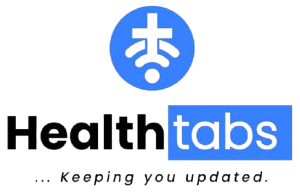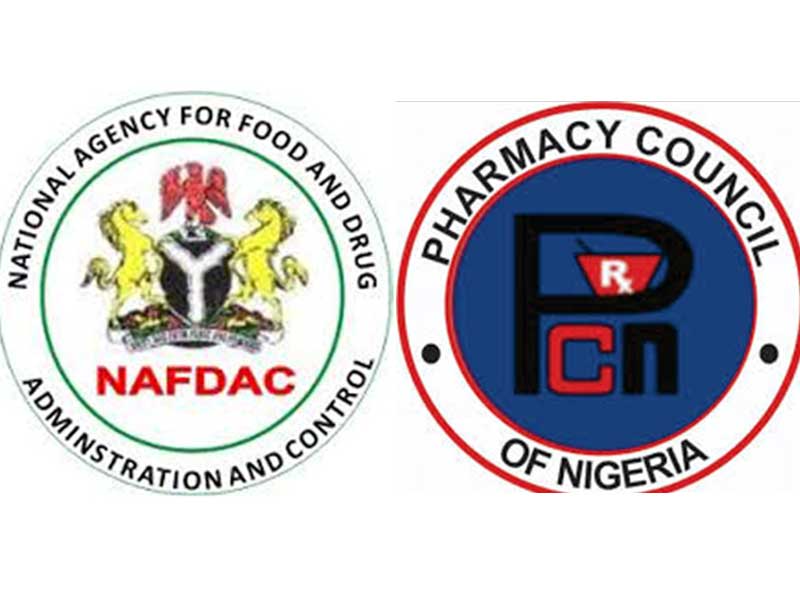Despite Nigeria’s Artificial Intelligence (AI) healthcare market being projected to grow from $0.01 billion in 2022 to $0.13 billion by 2030, at a staggering 46.22% compound annual growth rate, according to a healthcare market intelligence firm, Insights10, there are growing concerns about the real-world safety and effectiveness of some AI-powered health tools currently in use.
With a rising cost in healthcare and a health system characterized with just about 17 health facilities per 100,000 population and at the same time strained by limited infrastructure, high disease burden, and a critical shortage of medical personnel. The appeal for AI-powered solutions is undeniable and often marketed as life-enhancing and even life-saving alternatives.
In the race to digitize, fewer sectors have embraced AI with as much enthusiasm as healthcare. Among the most visible AI-driven consumer innovations in health are wristwatches and smart bands that promise to monitor blood pressure in real time. Cardiovascular diseases remain the leading cause of death worldwide and blood pressure monitoring is a cornerstone to ensuring cardiovascular health.
However, investigations into AI-powered wearable blood pressure monitors reveal a troubling side to this optimism. These devices, marketed as lifesavers, have demonstrated serious inaccuracies in detecting high blood pressure, sometimes giving false-negative results that delay diagnosis or treatment. Such discrepancies call into question the readiness of certain AI tools for clinical or even personal health decision-making, especially in a country grappling with limited access to formal care and soaring rates of hypertension-related illness.
While AI is often projected as a fix for healthcare access gaps, enabling remote diagnostics, personalized care, and task automation, its success depends not only on market potential but on rigorous validation, regulatory oversight, and user education. Inaccurate devices not only erode trust but may inadvertently worsen health outcomes they are intended to solve.
Wristwatches that monitor blood pressure include imported products like Ultra 8 Wristwatches, Oraimo 3 Pro OSW-34, Apple HK 8 Pro among other imported devices mainly from China. Nextwear Technologies, which is described as Nigerian first wearable technology company, also listed N-Alerte Wrist BP Monitor listed on its website.
According to Euromonitor’s 2024 report, despite economic challenges affecting most consumer electronics in Nigeria, wearable electronics continued to surge in sales. The report attributes this to rising health consciousness among Nigerians and concerns over health conditions like hypertension. In response, more consumers are turning to wearables to track vital health metrics. But while the demand booms, the science and safety behind some of these gadgets remain questionable. In 2023, Euromonitor predicted a 16.7% increase in the sale of smart wearables, up from 20,400 units sold in 2022.
Between Convenience and Clinical Reality
For Mariam Oyenpemi, wearable technology offers a glimpse into her health, but on her own terms. She is one of many Nigerians drawn to the convenience and sleek design of AI-powered wearables. Her choice, Oraimo Watch 5 Lite, is a budget-friendly smartwatch with blood pressure tracking capabilities.
“I got it mainly to monitor my sleep patterns and for fitness motivation,” she explained. “I’m not using it to monitor any health issues, so I don’t really take the blood pressure feature seriously. But when I work out, the values add up and make sense when I test them out.
”Mariam’s use of the device reflects a growing trend in Nigeria’s wearable tech market, which is a casual health tracking rather than medical reliance. Her experience, like that of many others, highlights the availability of data at one’s fingertips, even if the clinical accuracy remains questionable.
In the case of Oluwatobi Ojo, a medical professional and known hypertensive, the equation is more complex and potentially dangerous. She’s been wearing the Ultra 8 Smartwatch for nearly two years. While she appreciates the convenience, she’s never relied on the blood pressure feature. “As a medic, I know how important it is to get an accurate reading,” she said. “I use it to track steps and time, not my blood pressure.
”Still, in the spirit of inquiry, she agreed to put the device to the test. The watch displayed a reading of 120/84 mmHg, which indicates a borderline normal and certainly not alarming. But Ojo, who instantly became skeptical, wasted no time when she said: “This is not my blood pressure.” Her instinct was accurate.
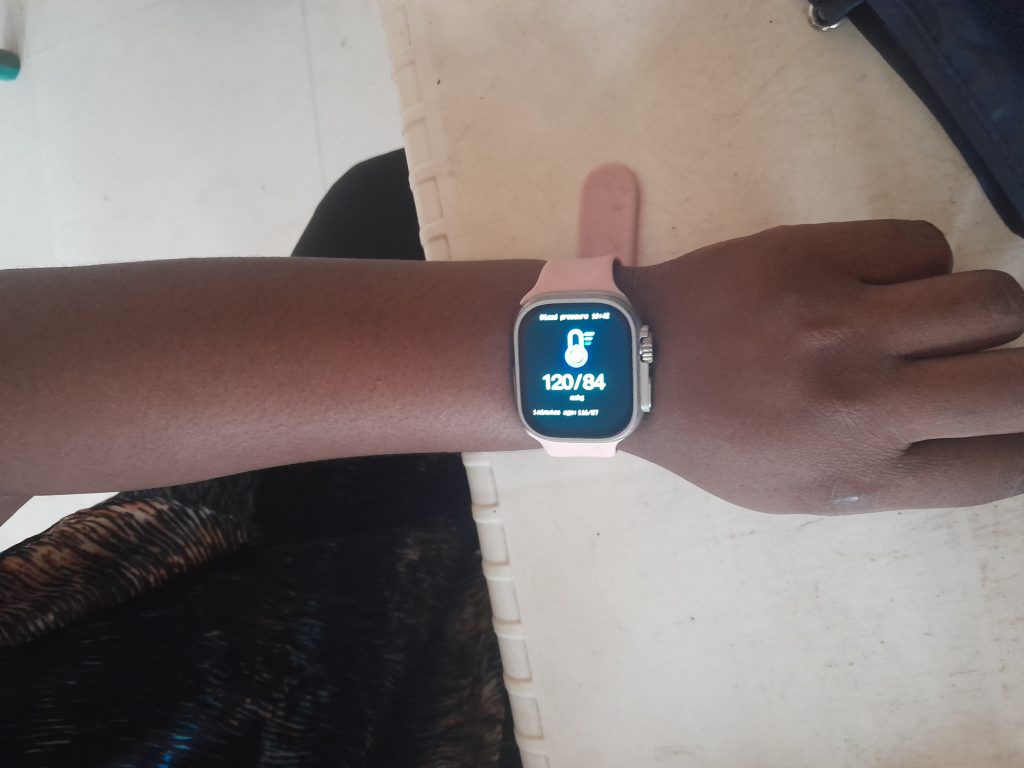
Ojo’s watch displays a blood pressure reading of 120/84 mmHg
Using two conventional and clinically accepted tools, a digital arm cuff and a manual aneroid sphygmomanometer, her actual blood pressure was revealed to be significantly higher: 145/95 mmHg and 150/100 mmHg respectively. These values fall squarely within Stage 2 hypertension according to the American Heart Association’s classification, a level that requires close medical management.
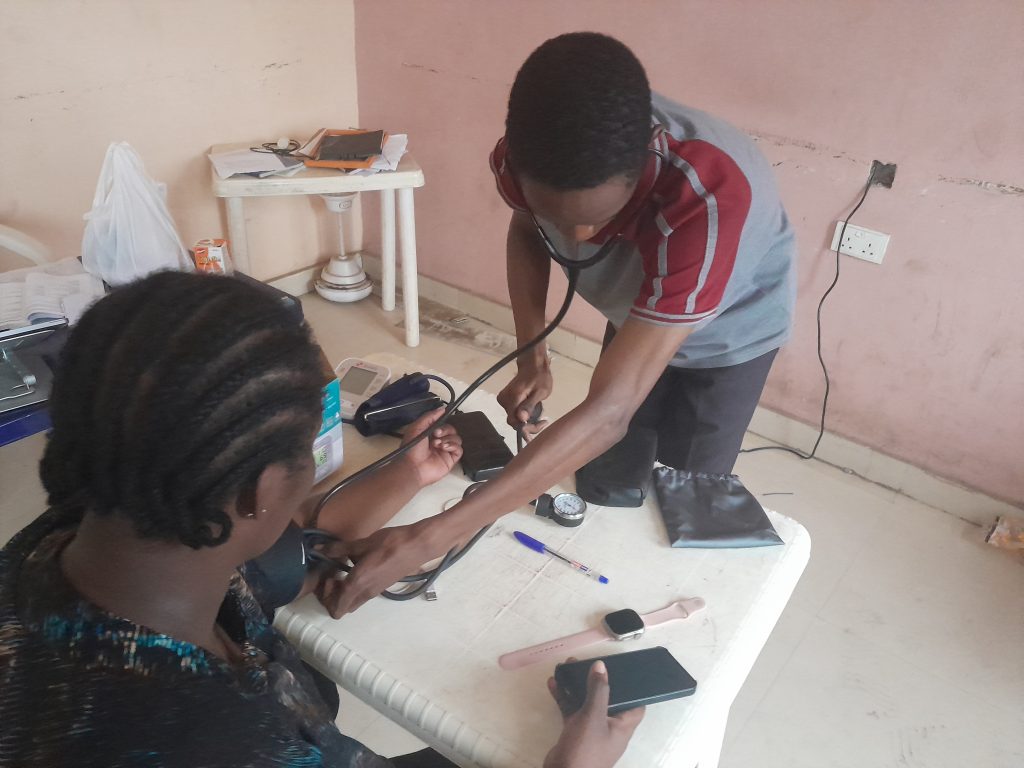
Ojo’s blood pressure examined using a digital arm cuff and aneroid sphygmomanometer
Ojo’s experience isn’t just an anecdote; it is a cautionary tale for an increasingly health-conscious population that may unknowingly depend on unreliable metrics. “I’ve never trusted the watch’s BP readings,” she said, “but if its accuracy improves, I’d definitely use it more for that purpose.”
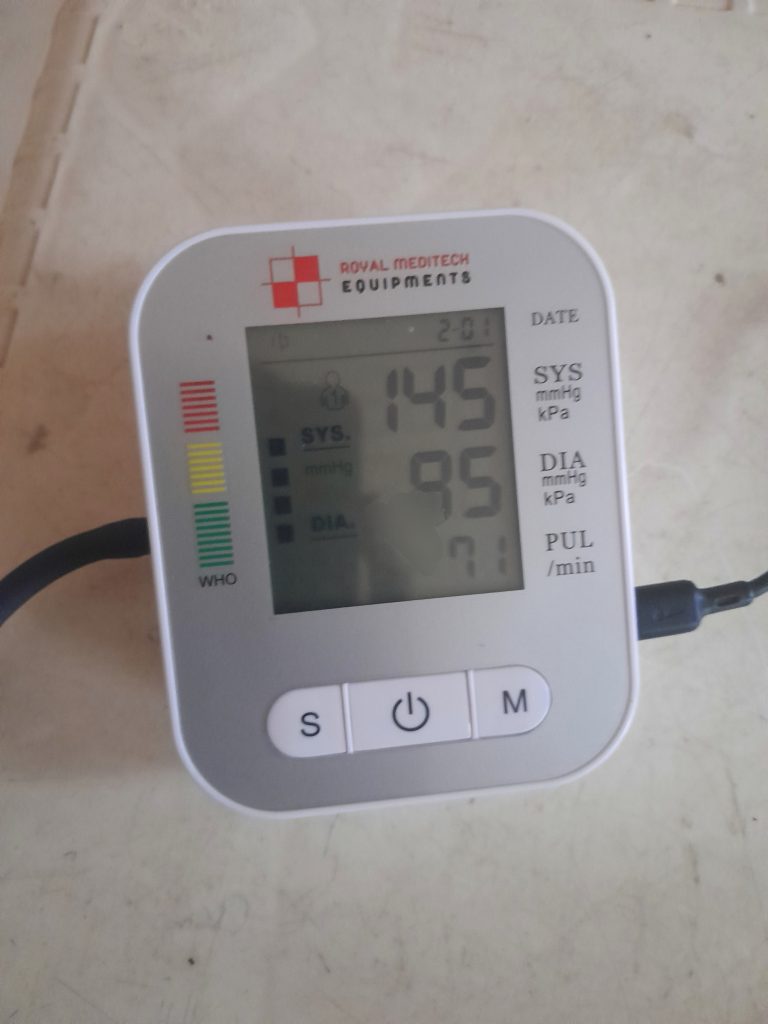
Reading obtained from the digital cuff sphygmomanometer
As more Nigerians adopt wearables for health monitoring amid suboptimal healthcare access and rising cases of hypertension, these real-world stories reinforce the need for rigorous validation, public education, and regulatory oversight in a fast-growing tech-health marketplace. Ultra 8 Smartwatches are produced by a Chinese company, Shenzhen Innovative R and D Technology Co., Ltd.
Classification of Hypertension according to the American Heart Association
| Blood Pressure Category | Systolic (upper number) | Diastolic (lower number) | |
| Normal | Less than 120 | and | Less than 80 |
| Elevated | 120 -129 | and | Less than 80 |
| Hypertension Stage 1 | 130 – 139 | or | 80 – 89 |
| Hypertension Stage 2 | 140 or higher | or | 90 or higher |
| Hypertensive Crises | Higher than 180 | or | Higher than 120 |
For Oreoluwa Nene, a 26-year-old entrepreneur, keeping tabs on her blood pressure had become part of his daily self-care routine especially after her mother suffered a stroke last year. She opted for convenience when she began wearing her Itel ISW-021 watch in February 2025.
“I work long hours, barely have time for clinic visits, and this watch seemed like the perfect hack,” she said, adjusting the strap on his wrist.
However, a routine visit to a pharmacy turned into an unexpected revelation. The pharmacist offered to check her vitals before administering antimalarial medications which she had gone to procure. Using a standard electronic sphygmomanometer with an arm cuff, the pharmacist recorded a blood pressure of 152/99 mmHg, a range of Stage 2 hypertension, similar to the case of Ojo.
Alarmed, Oreoluwa said she quickly checked the reading on her smartwatch and it showed 116/83 mmHg, a completely normal range.
“I was shocked and confused,” she recounted. “If I had relied only on the watch, I would’ve assumed I was perfectly fine.” This discrepancy raised immediate red flags, especially as Oreoluwa had begun skipping routine medical checkups, relying instead on the readings from her smartwatch. “It made me realize I was flying blind,” she admitted.
The inaccuracy echoes growing concerns within the medical community, that AI-powered health wearables, far from being medical devices, are largely unregulated consumer gadgets that can offer misleading reassurance or false alarms.
Lack of Global Standards Leaves Wearables in Limbo
There are burgeoning concerns about wearables clinical reliability, largely due to the absence of global validation standards.
Although published studies on wearable blood pressure technologies in Nigeria remain limited, a 2023 study by Nduneche Ezurike of LGIS University, USA, highlighted a notable rise in adoption among young Nigerians. The trend reflects broader global enthusiasm for smart health gadgets, but questions about their accuracy continue to loom.
For instance, a 2022 study led by Sheikh M.S. Islam of the Institute for Physical Activity and Nutrition at Deakin University, Australia, found no statistically significant difference between readings from wearable BP monitors and standard reference devices. However, the study emphasized the critical need to validate these devices using standardized protocols before recommending them for clinical use.
But not all wearables fare equally in scrutiny. A team led by Noud van Helmond, an anesthesiologist at the Sidney Kimmel Medical College in the United States, found the Everlast wristwatch to be unreliable for measuring blood pressure, despite being marketed and sold for that very purpose. This finding underscores the real-world risks of allowing unverified technologies to serve as health monitors.
Health authorities have taken note. The American Heart Association stresses that accurate blood pressure measurement is vital for risk classification and effective clinical decision-making. It continues to recommend the mercury sphygmomanometer operated by trained observers (auscultatory method) as the gold standard, along with validated aneroid and oscillometric devices.
Similarly, the World Health Organization (WHO), in its ‘Technical Specifications for Automated Non-Invasive Blood Pressure Measuring Devices with Cuff,’ discourages the use of cuffless techniques, such as those employed by many wearables and mobile apps. The WHO cautions that these devices lack validation under universally accepted standards and protocols.
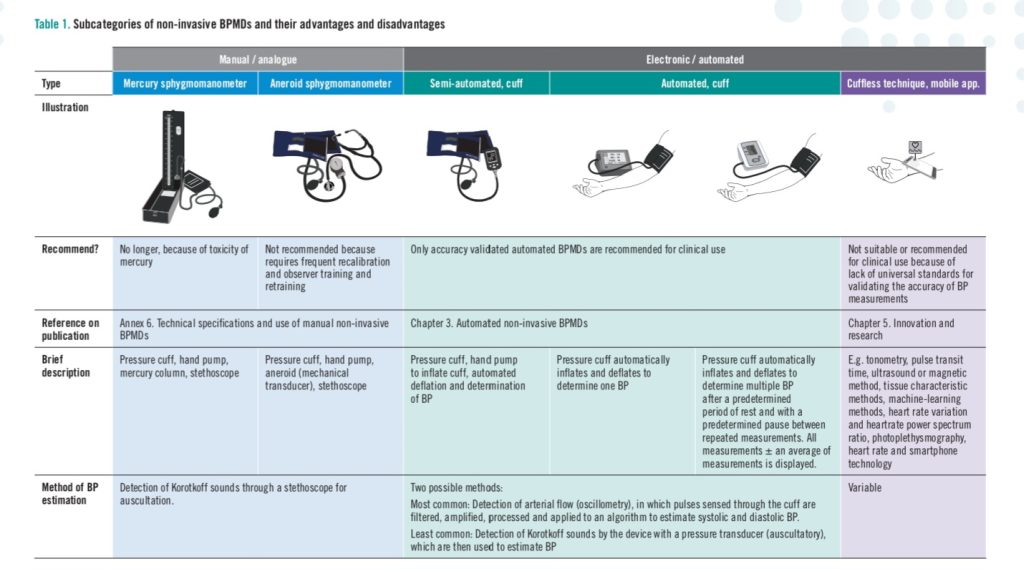
WHO Technical specifications for automated non-invasive blood pressure measuring devices with cuff
Globally recognized validation frameworks — like those from the Association for the Advancement of Medical Instrumentation (AAMI), the British Hypertension Society (BHS), and the European Society of Hypertension International Protocol (ESH-IP), remain the gold standard for determining the accuracy and safety of blood pressure devices. Yet many wearable manufacturers either bypass these protocols or provide limited transparency about their adherence.
Until universally accepted standards are mandated and enforced, wearable BP monitors will remain in a regulatory gray zone, branded as health tools but falling short of clinical expectations. This ambiguity risks undermining trust in digital health and could have dangerous consequences for users who unknowingly rely on inaccurate data.
Overreliance on AI Wearables for Blood Pressure Monitoring
A biomedical engineer at UNIOSUN Teaching Hospital in Osogbo, Engineer Ponnle, provided insight into the mechanics and limitations of wrist-based blood pressure monitoring while fielding questions on the growing adoption of wearable health devices.
“Standard blood pressure monitors with arm cuffs are designed to measure pressure in the brachial artery, which offers more reliable readings,” he explained. “Wrist monitors, on the other hand, measure pressure from the radial artery, which is closer to the skin surface and more susceptible to variations due to posture and positioning.”
Demonstrating a typical wrist-based digital monitor with a cuff, he added: “These devices are generally recommended only when upper arm sphygmomanometers are unavailable or cannot be used. Even then, they’re considered less accurate.”
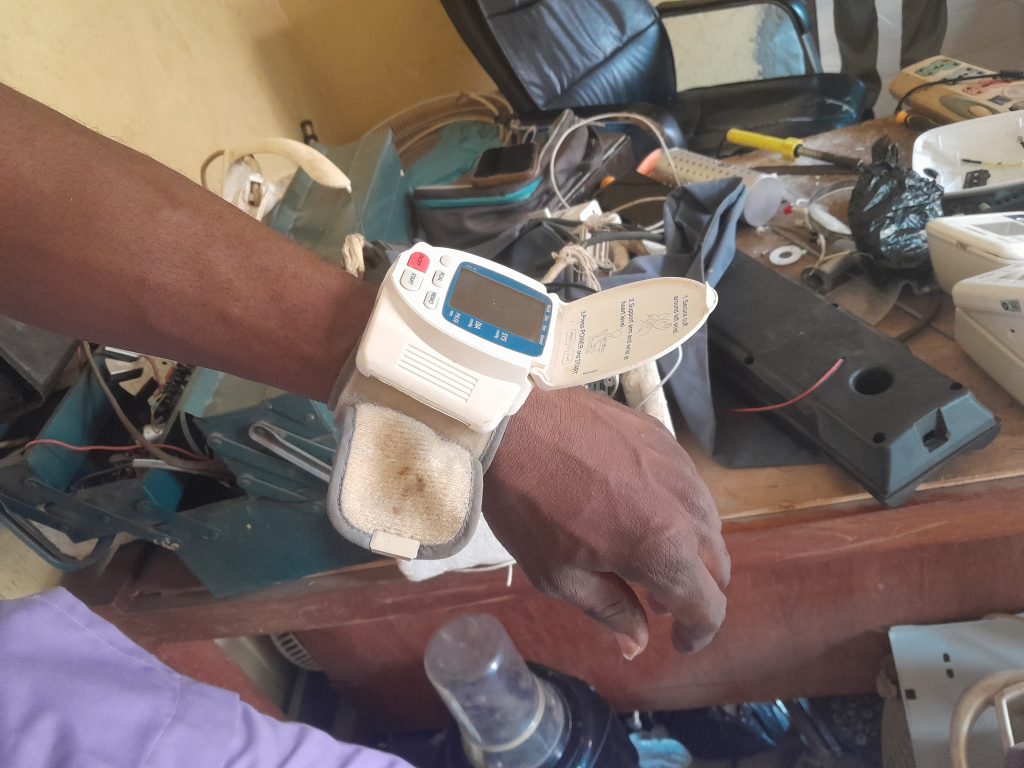
Engineer Ponnle demonstrates how to wear a wrist-based blood pressure monitor with cuff
When asked about smartwatches that claim to measure blood pressure without a cuff, Ponnle expressed skepticism. “These wristwatches use optical sensors to estimate blood pressure. They’re essentially imitations of wrist monitors, but without the compression mechanism. Most of them haven’t undergone validation by international standards organizations, and unfortunately, many still find their way into our markets unregulated,” he said during an interview in his office.
Dr. Ariyo, a resident doctor at the Department of Internal Medicine at the same hospital, highlighted the clinical risks associated with inaccurate blood pressure readings. “In cases of undetected or poorly monitored hypertension, patients could face severe complications such as stroke or end-organ damage,” he warned. “I’ve personally not encountered patients who rely on smartwatches for monitoring, but the risks are clear if these devices continue to grow in popularity unchecked.”
Adding a specialist’s perspective, Dr. Fatai Adebayo, a consultant cardiologist, voiced stronger reservations. “We do not recommend that patients use wristwatches to check their blood pressure. The reliability is questionable, and the consequences of acting on misleading data can be severe,” he stated in a chat with HealthTabs.
He pointed out that misinterpretation isn’t always about elevated values. “It’s not just about overestimating hypertension. Let’s say a smartwatch underreports a hypertensive patient’s reading. If a doctor increases the dosage based on a falsely high result, the patient might end up hypotensive, which can lead to dizziness, fainting, or even shock.”
Dr. Adebayo concluded with a call for caution: “For something as critical as blood pressure, patients should stick with clinically validated, medically approved tools. Technology is good but only when it’s accurate and regulated.”
A product Manager, Abass Owolabi while talking on his experience using a HK 8 Pro Max wristwatch that monitors blood pressure said it was ‘reasonably accurate’ with what he knew his blood pressure at the time. “Firstly, I think that product specifications should be followed. Products should be used as specified. We know it’s wireless, hence, a special care might be required. I’ve measured mine before using a smart watch and it was reasonably accurate with what I knew my BP was at that time,” the product manager said during a chat.
While commenting on how accuracy could be ensured in the devices, he called for an improvement in product development. “Another aspect is the Product Development itself. If all things are put together correctly, to mean, the product itself was designed properly and works well, one should get the result (sic),” he stated. He added that the products could also be designed to work with other devices that could help achieve better accuracy.
A software developer, Abdulmajeed Aladejana, said accuracy in blood pressure measurement by wristwatches can be ensured by compliance with the American Heart Association, Health Insurance Portability and Accountability Act protocols among other regulations. “Reviews, surveys, usage analytics and expert testing by health professionals are other ways feedback is used for updating the software,” Aladejana stated. However, he added that the errors are not solely machine-dependent as errors may be from the position of the patient or other factors that are totally independent of the devices.
Rukayah Oyerinde, a visual designer, stressed the complexity of designing a self-monitoring device by users who are non-experts. “It’s a little bit hard because it requires a lot of creativity but the users still hold a lot of influence since the products are ultimately meant for them,” she stated.
Young, Wired and at Risk
For a generation that has grown up alongside rapid technological advancement, young Nigerians are embracing digital health tools with enthusiasm. Wearable health tech, particularly AI-powered wristwatches that promise real-time blood pressure monitoring, has become a popular lifestyle companion for many.
But as users revealed, this convenience often comes at the expense of accuracy. Oreoluwa Nene turned to wearable technology after her mother suffered a stroke. For her, the smartwatch seemed like a brilliant solution, fitting seamlessly into her packed schedule while offering a sense of health assurance. But a pharmacy visit, where her actual blood pressure was found to be dangerously high, exposed the limits of the device. “If I had relied only on the watch,” she said, “I would’ve assumed I was perfectly fine.”
Her case reflects a broader reality. Young Nigerians are health-conscious and open to innovation, but many lack the clinical awareness to differentiate between lifestyle tech and medical-grade tools. It’s a gap that could have real consequences, especially in a country already burdened by increasing the number of high blood pressure with limited access to healthcare by the population.
Mariam Oyenpemi, another user, echoed this sentiment. Though she wears her smartwatch for sleep tracking and workouts, she doesn’t put much stock in its blood pressure readings. “I’m not using it to monitor any health issues, so I don’t really take the blood pressure feature seriously,” she said. Yet she admitted the readings sometimes “add up” when compared casually with standard measurements.
Mariam and Oreoluwa’s experiences offer a valuable lesson for Nigeria’s tech-leaning youth. Technology is only as powerful as the awareness that guides its use. Oreoluwa’s realization of ‘flying blind’ highlights the need for a health device to be tested, not just trusted. As Nigeria’s digital health market grows, these personal reflections reiterate the need to understand that the future of health tech belongs not just to innovation but to education, validation, and responsible adoption.
Silence from the Regulators
Despite multiple attempts to obtain official clarification on the regulation of AI-powered blood pressure monitors in Nigeria, relevant agencies have so far failed to provide responses. Nextwear Technologies, one of the companies producing and marketing such devices locally, was contacted through its co-founder, Bisola Bolarinwa; no response had however been received at the time of filing this report.
The National Agency for Food and Drug Administration and Control (NAFDAC), through its Reforms Unit, directed inquiries to the NAFDAC Directorate of Planning, Research and Statistics. However, follow-up emails to the Directorate have gone unanswered.
Similarly, the Federal Competition and Consumer Protection Commission (FCCPC) neither responded to an official email nor provided any comment after follow-up phone calls. This lack of response underscores a troubling opacity in the regulation and oversight of wearable health devices that are increasingly relied upon by consumers to make potentially life-altering health decisions.
This report was produced with support from the Centre for Journalism Innovation and Development (CJID) and Luminate
